Tynedale

Tynedale was a local government district in Northumberland, England. The district had a resident population of 58,808 according to the 2001 census. The main towns were Hexham, Haltwhistle and Prudhoe. The district contained part of Hadrian's Wall and the southern part of Northumberland National Park. With an area of 2,219 km2 (857 sq mi) it was the second-largest English district, after the East Riding of Yorkshire. It was bigger than several English counties, including Nottinghamshire, Leicestershire and Hertfordshire. It was also the second-least densely populated district (behind Eden, Cumbria). The district was formed on 1 April 1974, under the Local Government Act 1972, and was a merger of Hexham and Prudhoe urban districts, along with Bellingham, Haltwhistle and Hexham rural districts. Tynedale was historically a liberty created alongside the county of Hexhamshire by Henry I of England. The district was abolished as part of the 2009 structural changes to local government in England effective from 1 April 2009 with responsibilities being transferred to Northumberland County Council, a unitary authority. However, the name "Tynedale", which predates the formation of the council, is still widely used for the Tyne Valley area of Northumberland.
Excerpt from the Wikipedia article Tynedale (License: CC BY-SA 3.0, Authors, Images).Tynedale
East Lea,
Geographical coordinates (GPS) Address Nearby Places Show on map
Geographical coordinates (GPS)
| Latitude | Longitude |
|---|---|
| N 55.036 ° | E -2.127 ° |
Address
East Lea
NE46 4BU , Humshaugh
England, United Kingdom
Open on Google Maps








